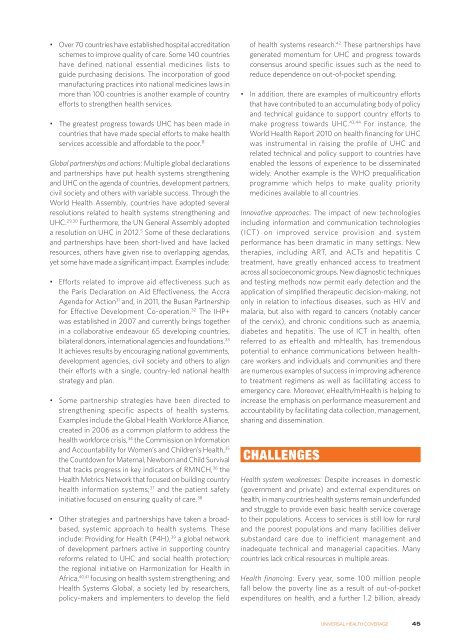You also want an ePaper? Increase the reach of your titles
YUMPU automatically turns print PDFs into web optimized ePapers that Google loves.
• Over 70 countries have established hospital accreditation<br />
schemes <strong>to</strong> improve quality of care. Some 140 countries<br />
have defined national essential medicines lists <strong>to</strong><br />
guide purchasing decisions. The incorporation of good<br />
manufacturing practices in<strong>to</strong> national medicines laws in<br />
more than 100 countries is another example of country<br />
efforts <strong>to</strong> strengthen health services.<br />
• The greatest progress <strong>to</strong>wards UHC has been made in<br />
countries that have made special efforts <strong>to</strong> make health<br />
services accessible and affordable <strong>to</strong> the poor. 11<br />
Global partnerships and actions: Multiple global declarations<br />
and partnerships have put health systems strengthening<br />
and UHC on the agenda of countries, development partners,<br />
civil society and others with variable success. Through the<br />
World Health Assembly, countries have adopted several<br />
resolutions related <strong>to</strong> health systems strengthening and<br />
UHC. 29,30 Furthermore, the UN General Assembly adopted<br />
a resolution on UHC in 2012. 5 Some of these declarations<br />
and partnerships have been short-lived and have lacked<br />
resources, others have given rise <strong>to</strong> overlapping agendas,<br />
yet some have made a significant impact. Examples include:<br />
• Efforts related <strong>to</strong> improve aid effectiveness such as<br />
the Paris Declaration on Aid Effectiveness, the Accra<br />
Agenda for Action 31 and, in 2011, the Busan Partnership<br />
for Effective Development Co-operation. 32 The IHP+<br />
was established in 2007 and currently brings <strong>to</strong>gether<br />
in a collaborative endeavour 65 developing countries,<br />
bilateral donors, international agencies and foundations. 33<br />
It achieves results by encouraging national governments,<br />
development agencies, civil society and others <strong>to</strong> align<br />
their efforts with a single, country-led national health<br />
strategy and plan.<br />
• Some partnership strategies have been directed <strong>to</strong><br />
strengthening specific aspects of health systems.<br />
Examples include the Global Health Workforce Alliance,<br />
created in 2006 as a common platform <strong>to</strong> address the<br />
health workforce crisis, 34 the Commission on Information<br />
and Accountability for Women’s and Children’s Health, 35<br />
the Countdown for Maternal, Newborn and Child Survival<br />
that tracks progress in key indica<strong>to</strong>rs of RMNCH, 36 the<br />
Health Metrics Network that focused on building country<br />
health information systems; 37 and the patient safety<br />
initiative focused on ensuring quality of care. 38<br />
• Other strategies and partnerships have taken a broadbased,<br />
systemic approach <strong>to</strong> health systems. These<br />
include: Providing for Health (P4H), 39 a global network<br />
of development partners active in supporting country<br />
reforms related <strong>to</strong> UHC and social health protection;<br />
the regional initiative on Harmonization for Health in<br />
Africa, 40,41 focusing on health system strengthening; and<br />
Health Systems Global, a society led by researchers,<br />
policy-makers and implementers <strong>to</strong> develop the field<br />
of health systems research. 42 These partnerships have<br />
generated momentum for UHC and progress <strong>to</strong>wards<br />
consensus around specific issues such as the need <strong>to</strong><br />
reduce dependence on out-of-pocket spending.<br />
• In addition, there are examples of multicountry efforts<br />
that have contributed <strong>to</strong> an accumulating body of policy<br />
and technical guidance <strong>to</strong> support country efforts <strong>to</strong><br />
make progress <strong>to</strong>wards UHC. 43,44 For instance, the<br />
World Health Report 2010 on health financing for UHC<br />
was instrumental in raising the profile of UHC and<br />
related technical and policy support <strong>to</strong> countries have<br />
enabled the lessons of experience <strong>to</strong> be disseminated<br />
widely. Another example is the WHO prequalification<br />
programme which helps <strong>to</strong> make quality priority<br />
medicines available <strong>to</strong> all countries.<br />
Innovative approaches: The impact of new technologies<br />
including information and communication technologies<br />
(ICT) on improved service provision and system<br />
performance has been dramatic in many settings. New<br />
therapies, including ART, and ACTs and hepatitis C<br />
treatment, have greatly enhanced access <strong>to</strong> treatment<br />
across all socioeconomic groups. New diagnostic techniques<br />
and testing methods now permit early detection and the<br />
application of simplified therapeutic decision-making, not<br />
only in relation <strong>to</strong> infectious diseases, such as HIV and<br />
malaria, but also with regard <strong>to</strong> cancers (notably cancer<br />
of the cervix), and chronic conditions such as anaemia,<br />
diabetes and hepatitis. The use of ICT in health, often<br />
referred <strong>to</strong> as eHealth and mHealth, has tremendous<br />
potential <strong>to</strong> enhance communications between healthcare<br />
workers and individuals and communities and there<br />
are numerous examples of success in improving adherence<br />
<strong>to</strong> treatment regimens as well as facilitating access <strong>to</strong><br />
emergency care. Moreover, eHealth/mHealth is helping <strong>to</strong><br />
increase the emphasis on performance measurement and<br />
accountability by facilitating data collection, management,<br />
sharing and dissemination.<br />
CHALLENGES<br />
Health system weaknesses: Despite increases in domestic<br />
(government and private) and external expenditures on<br />
health, in many countries health systems remain underfunded<br />
and struggle <strong>to</strong> provide even basic health service coverage<br />
<strong>to</strong> their populations. Access <strong>to</strong> services is still low for rural<br />
and the poorest populations and many facilities deliver<br />
substandard care due <strong>to</strong> inefficient management and<br />
inadequate technical and managerial capacities. Many<br />
countries lack critical resources in multiple areas.<br />
Health financing: Every year, some 100 million people<br />
fall below the poverty line as a result of out-of-pocket<br />
expenditures on health, and a further 1.2 billion, already<br />
UNIVERSAL HEALTH COVERAGE<br />
45


